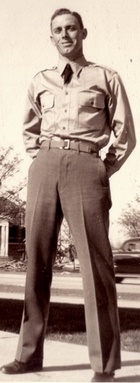John Campbell
| Date and Place of Birth: | July 4, 1917 Hightstown, NJ |
| Date and Place of Death: | March 31, 1943 Mediterranean Sea |
| Baseball Experience: | College |
| Position: | Unknown |
| Rank: | Second Lieutenant |
| Military Unit: | 448th Bomb Squadron, 321st Bomb Group USAAF |
| Area Served: | Mediterranean Theater of Operations |
John F. Campbell, son of Clarence and Margaret Campbell, was born in
Hightstown, New Jersey on July 4, 1917. His father was a carpet weaver,
and John Campbell attended Hightstown High School and the
Peddie School in Hightstown, where he excelled in athletics.
He entered Dickinson College at Carlisle, Pennsylvania in 1937. Campbell
played varsity baseball, soccer and basketball at Dickinson, and was
sports editor of the college yearbook and vice-president of the student
athletic association.
Campbell graduated from Dickinson in June 1941 and soon enlisted in the
Army Air Corps. Training as a flying cadet, he was commissioned in the
fall of 1942.
On February 11, 1943, it was announced that Second Lieutenant Campbell
was engaged to Ruth Coleman, a senior at Dickinson at the time. Three
days later, Campbell’s squadron, the 448th Bomb Squadron, 321st Bomb
Group, received orders assigning them to North Africa.
On February 15, 1943, a 54-plane formation of North American B-25
Mitchell’s left Brooks Field, West Palm Beach, Florida to begin the
first leg of the overseas journey. Campbell was co-pilot of B-25 serial
number 41-29769.
For refuelling and maintenance checks the formation made stops at Puerto
Rico, British Guiana, Brazil, Ascension Islands, Liberia, French West
Africa and Marrakech. They landed at their final destination, Oujda in
French Morocco on March 2, 1943. It was the first time a group had
successfully made the crossing in a single formation without losing an
airplane.
On March 12, 1943, the 321st Bomb Group moved to Ain M’lila in Algeria,
a forward airfield, and flew their first mission against a German
landing ground at Mezzouna in Tunisia on March 15, 1943.
Just two weeks later, on March 31, Second Lieutenant Campbell and six
other crew members failed to return from a sea sweep mission off
northeastern Tunisia. He was posted missing and later
declared as killed in action. The other crew members were:
1/Lt. McKinney, Charles A.
S/Sgt.Kirol, Edward A.
S/Sgt. Ratajczyk, Thomas S.
S/Sgt. Headings, Boyd V.
S/Sgt. McGinnis, Lofton F.
Sgt. Lottes, Richard O.
John Campbell received the Air Medal and Purple Heart. His body was
never recovered and it is believed his plane crashed in the
Mediterranean Sea. He is memorialized at the North Africa American
Cemetery at Carthage, Tunisia.
Sources:
Some of the above information was obtained from the Dickinson College
website and the 321st Bombardment Group website. Thanks, also, to
Barbara Ennis Connolly, 57th Bomb Wing Historical Researcher,319th &
321st BG Historian.
Date Added: May 5, 2013 Updated July 5, 2013
Can you add more information to this biography and help make it the best online resourse for this player? Contact us by email
Read Baseball's Greatest Sacrifice Through The Years - an online year-by-year account of military related deaths of ballplayers
Baseball's Greatest Sacrifice is associated with Baseball Almanac
Baseball's Greatest Sacrifice is proud to be sponsored by




